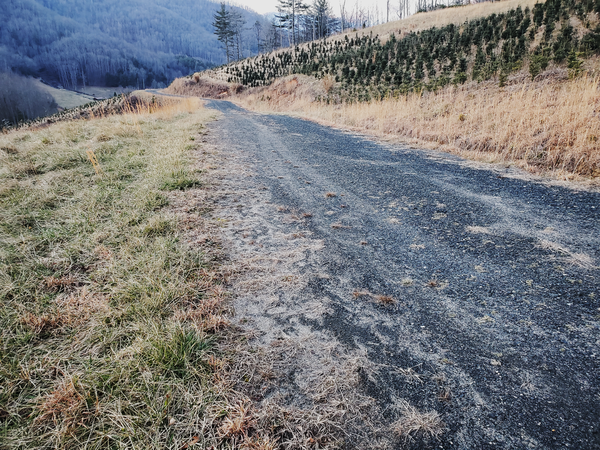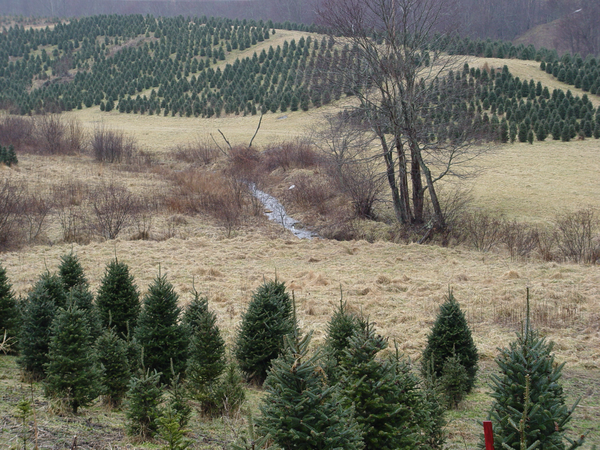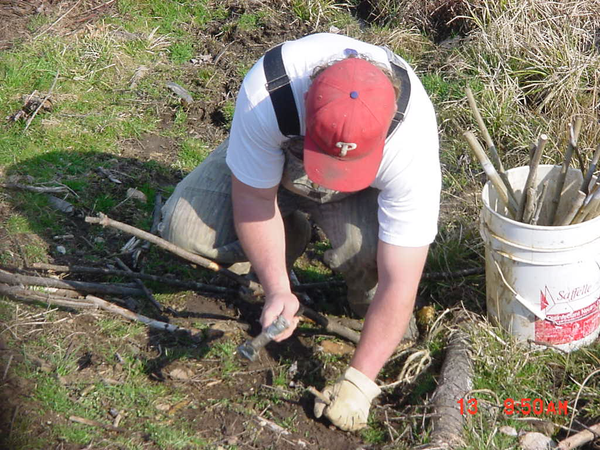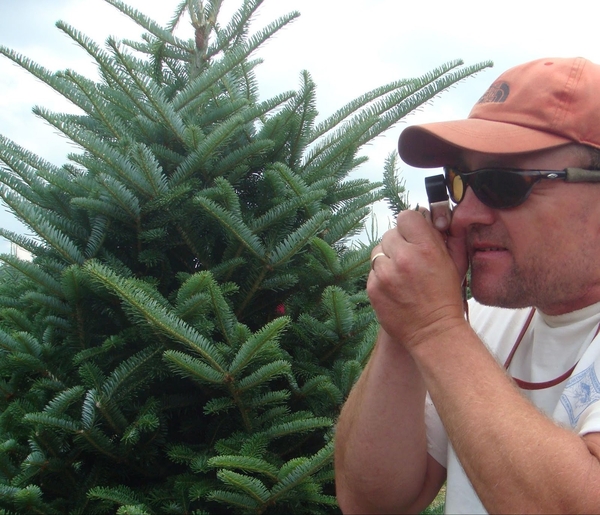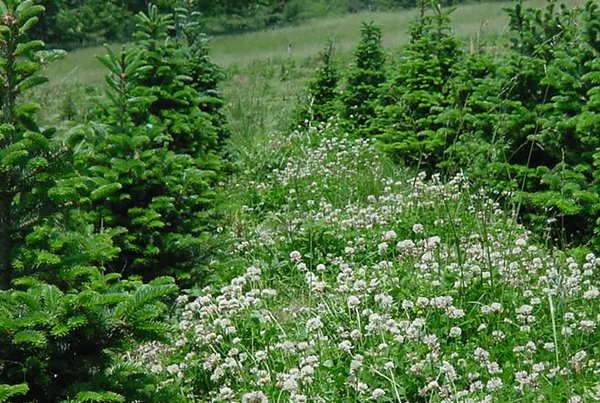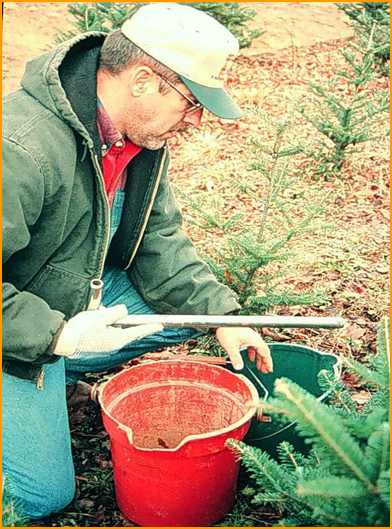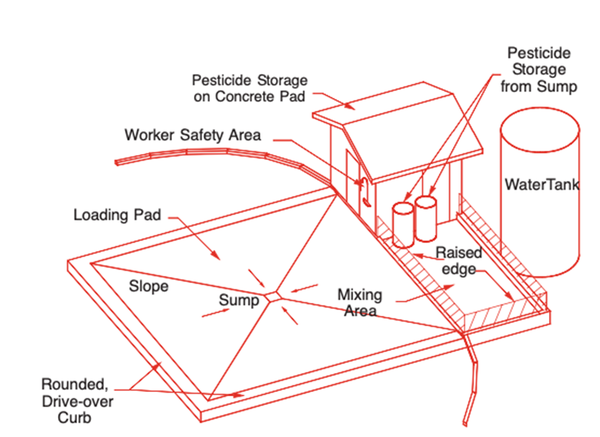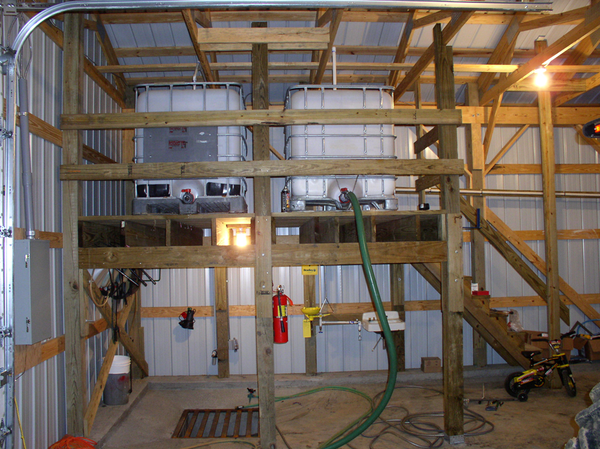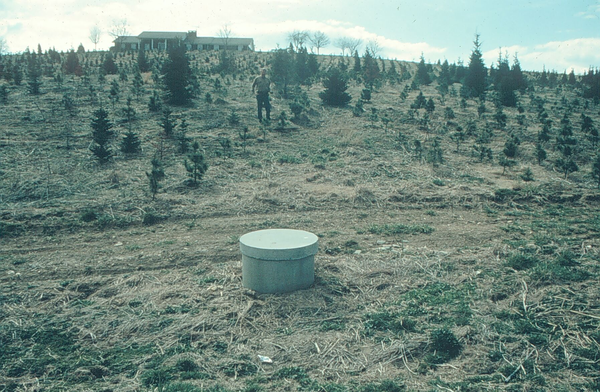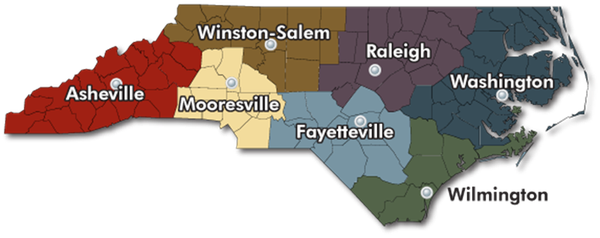Are you using best management practices on your Christmas tree farm?
High quality Christmas trees and profitability are important objectives that guide a successful Christmas tree farm operation. In addition to targeting clear economic goals, a farmer should manage the crop in such a way that production can be sustained well into the future. Protecting land and water resources goes hand-in-and with profitability.
Protecting land, water, and the future sustainability of a farm involves a number of different practices. Soil must be protected from erosion. Surface water and groundwater must be protected from sedimentation and contamination by fertilizers or pesticides. The health of farm workers should not be endangered by improper handling, storage, or use of farm chemicals. Farming practices should minimize negative impacts on wildlife. Collectively, alternative production practices that protect water quality and the environment while sustaining the farm economy are called best management practices (BMP’s).
Christmas tree farmers who invest in BMP’s usually show a greater long-term profit because land is maintained at higher productivity on several levels. Wise use of pesticides usually has a direct benefit in reduced pest injury to trees, and frequently, reduced pesticide expenses. Proper management of surface water across the farm landscape decreases the risk of establishing and spreading Phytophthora root rot. This disease represents the greatest potential loss of productive farmland to Christmas tree growers and represents the largest ulterior motive for investing in water quality BMP’s. Investment in the health and safety of farmworkers can increase worker productivity as well as avoid costly hospital bills and fines. These are just a few examples of economic returns resulting from BMP’s. The combination of practices discussed in this fact sheet have potential to sustain and extend the life of Christmas tree production on any farm. As stewards of their land, most farmers will also value intrinsic benefits from soil conservation, improved water quality, and creation of fish and wildlife habitat.
How can we help?
This publication is a summary of best management practices to protect your land, nearby streams, and the environment. The aim is to raise your awareness of the best approaches to accomplishing these goals. By reading each section and answering a series of questions, you will be able to determine which areas need work on your farm.
Each section deals with a different topic. Accompanying each topic is a question designed to help you evaluate your practices within that topic.
• If you answer “a” or “b,” you are doing well in this area.
• If you answer “c” or “d,” your practices could stand to be improved.
The goal of the North Carolina Farm*A*Syst program is to help you protect the natural resources that all North Carolina residents depend on, while maintaining a viable agricultural enterprise.
If you would like further help in assessing the condition of your farm, please visit your nearest Extension Center, your local Natural Resources Conservation Service office, or your North Carolina Soil and Water Conservation District. You can also study other fact sheets and publications available on these organizations’ websites.
Best Management Practices
_________________________________________________
1. How are your farm roads constructed?
The roads on many Christmas tree farms are too steep, are constructed of easily erodible material, and/or are poorly designed to manage runoff water. Roads should be constructed at no more than a 9 percent grade to avoid washing out. If roadbeds are sloped toward drainage ditches lined with filter cloth covered with small rock or riprap, runoff can be directed off of roadbeds and also away from tree fields. Proper construction can prevent formation of gullies often associated with unprotected ditches. Installing a stable road surface to handle traffic is also critical. As grade, slope length, or traffic increase, a properly graveled surface becomes much more likely to stay in place than a grass surface. Gravel may be spread just in the wheel tracks to reduce costs on less frequently traveled roads. In addition to protecting water quality from sedimentation, proper road and ditch construction has an added benefit of reducing risk of establishing Phytophthora root rot in adjoining fields.
Soil conservationists can help farmers as they plan for long-lasting roads or work to solve existing road problems. A professional can suggest a number of subtle design features that can add life to a road, reduce maintenance costs, and provide a more comfortable ride. For example, broad-based dips might be designed into road construction instead of relying on short-lived and bumpy water bars. By reducing grade over a length of road, broad-based dips spread out and slow down water runoff to reduce its force. Incorporating stable design features in initial construction are less costly than repairing repeated failures over the life of the road.
1. Select the answer that best describes your farm roads.
a. Gravel with slopes less than 9 percent, broad-based dips to slow and divert runoff, and adequate ditches lined with filter cloth and riprap.
b. Grassed with slopes less than 9 percent and maintained water bars to divert runoff.
c. Grassed with slopes of 10 percent or more.
d. Bare soil with slopes of 10 percent or more.
2. Are you using field borders and stream buffers effectively?
Field borders and stream buffers can be very effective in trapping sediment, nutrients, and pesticides present in runoff. To maximize this trapping effect, water leaving the field must be distributed as evenly across the field border as possible. By reducing the velocity of runoff, sediment and the nutrients and pesticides it contains settle out before reaching the stream. If water enters the buffer from gullies or narrow drainage points in the field, it will cut a channel through the buffer rather than slowing down and dispersing. Channelized runoff water will pass through the buffer zone with a full sediment load. Studies have shown that a 15- to 25-foot-wide grassy strip can be very effective in improving runoff water quality. Stream buffers can double as field roads as long as vegetation covers them rather than gravel.
Farmers might regret losing productive land to stream buffers, but that should not be true for Christmas tree growers. Few Christmas tree species thrive in water-saturated soils along stream banks. Bottomlands and draws along streams are the landscape positions most likely to result in Phytophthora root rot mortality and should be avoided for that reason alone. Designating these areas as field buffers will potentially reduce the risk of spreading this disease which is carried in water-borne sediment and enhanced by water-logged soil conditions.
Stream buffers installed primarily for disease or water quality protection can serve a number of different stewardship objectives on farms. When planted with flowering native plants, they serve as habitats for beneficial predators of several insect and mite pests of Christmas trees. Farmers can choose wildflower mixes that support honey bees or certain species of butterflies including Monarchs. Christmas tree growers can increase quail populations if they substitute native grasses in place of tall fescue which impedes young birds. By planting “live stakes” to establish woody broadleaf vegetation along stream edges, summer water temperatures drop and trout and other gamefish populations rebound. Field buffers can also be established as alternative food plots for deer to give them something else to eat other than Christmas trees.
2. Select the answer that best describes the buffers or borders at the edges of your fields.
a. They have good cover and no gullies or deep channels leading to or in the buffer.
b. They have good cover, but some gullies have formed leading to or in the buffer.
c. They are sparsely vegetated and have gullies or deep channels.
d. There are no buffers or borders adjacent to streams or drainage ways.
3. Do you use low-impact site preparation methods in areas that need it?
Some land currently in Christmas tree production is too steep and erodible to bear extensive mechanical site preparation. Without proper care, site preparation can lead to sparse vegetation, exposure of soils to erosion, and sediment-filled runoff. Some mountain soils may be too shallow or easily compacted to withstand heavy equipment. Compacted soils contribute to poor transplant establishment as well as the onset of Phytophthora root rot disease.
Less disruptive site preparation practices have been developed for such sites. Timber and brush should be cut close to the ground without disturbing the mat of roots that hold soil in place. Saw logs and firewood can be harvested without disturbing topsoil. Brush can be burned or piled in non-productive draws or field edges. Windrows of brush at forest edges have the added benefit of impeding field access to deer. Leave all or most of the stumps undisturbed. Do not attempt tillage. If seedlings are planted mechanically, plant areas near stumps by hand or leave that small percentage of transplant sites empty.
This low-impact strategy comes with several tradeoffs. Hardwood sprouts from stumps are a greater problem with this approach, but herbicides such as Roundup and Garlon* can control them. This no-till system can make achieving soil fertilization goals more difficult because nutrients like phosphorus and calcium are not incorporated into the soil. With time, nutrient deficiencies can be corrected manually. On the plus side, minimizing the disturbance of topsoil will allow sustained Christmas tree production on sites where heavy equipment would permanently damage soil productivity through erosion and compaction. On many mountain farms there really is no other effective management choice.
Where heavy equipment is going to be employed, use a track hoe to pull stumps from the ground rather than a bulldozer. The blades on bulldozers scrape, seal, and compact the soil surface in the process of pushing stumps out. Soil will be less disturbed and less compacted using a track hoe. Before using any heavy equipment, be sure soils are dry enough to minimize compaction. Pressure wash and/or steam clean equipment to avoid spreading Phytophthora root rot from field to field if it is known to be present.
3. Select the answer that best describes how you prepare your site for planting.
a. I cut all vegetation and remove it as firewood or place it in burn piles and leave all stumps in the ground.
b. I cut all vegetation and remove it as firewood or place it in burn piles and pull stumps using a track hoe.
c. I push and pile all vegetation using a bulldozer and pull stumps using a track hoe.
d. I push and pile all vegetation and stumps using a bulldozer.
4. Do you use pest scouting to minimize pesticide applications?
By scouting for pests, growers can reduce the frequency of pesticide applications and the cost of pest management while increasing the effectiveness of their efforts. Pest thresholds and scouting methods have been developed for major Christmas tree pests (see the Fraser Fir Scouting Manual). Information generated by scouting confirms whether pesticide applications are needed, assures that such applications are only targeted to potentially damaging pest populations, and documents the effectiveness of recent applications.
In recent years, departments of agriculture in other states have increased inspections and quarantines of Fraser fir Christmas trees infested with Elongate Hemlock Scale (EHS) and/or Cryptomeria Scale. Christmas tree growers are making more frequent preventative pesticide applications to try to meet zero-tolerance pest thresholds expected by regulators and wholesale customers in those states. These regulatory constraints override integrated pest management principles and reliance on scouting-based EHS thresholds. However, scouting is still a vital tool to monitor EHS, other insect or mite pests, diseases, weeds, nutrient deficiencies, or other problems. Further, scouting provides an essential verification of treatment effectiveness when pesticides are used.
4. Select the answer that best describes how you apply pesticides.
a. Pesticides are applied only after a regular scouting reveals a pest population at or above the treatment threshold in that field.
b. Pesticides are applied only after a pest problem is noticed and the field is scouted.
c. Pesticides are applied on a schedule developed over the years or on a regular basis as time allows.
d. Pesticides are applied to your trees when your pesticide dealer tells you to or your neighboring Christmas tree grower or a friend applies that product to his or her own trees.
5. Are you making safe pesticide application decisions?
After a pest is found and identified, the best treatment must be determined. This may include pesticide application and / or an array of other pest management practices. Many pesticides are labelled for the control of each Christmas tree pest of which some are more effective at control than others. While treatment efficacy is a primary factor in the decision-making process, it is not the only one. When choosing from a pool of similarly effective treatments, growers should select the pesticide that is least toxic to people, beneficial insects, the environment, and wildlife.
The licensing and labeling of pesticides are the culmination of extensive research by companies and universities to insure product safety. Following the label instructions for personal protective equipment and safe handling insure that those workers mixing a pesticide and those applying it are adequately protected. Worker protection training is required by law and reinforces pesticide label directions. Education and label instruction extend to environmental concerns as well as worker safety.
The toxicity of certain pesticides to specific groups of animals, such as bees, fish or aquatic insects, can vary significantly. Safe pesticide choices will change depending on how close a site is to critical habitats or even the season and life cycle of vulnerable wildlife species. Some less-toxic materials may require different equipment, handling, or timing than are needed for traditional pesticides. Be sure to evaluate all factors when selecting a pesticide and to read and follow label directions. For some pests, growers can apply pesticides at alternative times, such as fall or winter, when beneficial insects or at-risk wildlife are not present.
5. Select the answer that best describes the factors you consider when selecting the pesticides to use on your farm.
a. The product and timing that are least toxic to people, non-target organisms, and the environment.
b. The product requiring the lowest application rate or the product least toxic to the person applying the pesticide.
c. What my neighbors are using.
d. The least expensive product available.
6. Do you manage ground covers to optimize sustained production?
Weed management is an absolutely critical component of Christmas tree production. Unchecked weed competition can stunt and/or deform tree growth, but total removal of ground cover results in soil erosion that shortens the productive life of a farm. The presence of eroded gullies reflects a reduction in soil depth, impaired soil drainage, and unmanaged surface-water runoff – all which increase risk of Phytophthora root rot establishment and spread. A balance is needed between weed control and protecting the soil surface.
Concerned growers have moved away from predominant use of long-lasting preemergent herbicides or any bare-ground weed control. They use herbicide-suppressed ground covers as the primary tool for stabilizing the soil within a field of trees. Best management practices involve suppression of native vegetation using low rates of post emergent herbicides to favor weed species such as white clover which make ideal cover crops. This reduces competition for nutrients, water, and space while protecting the soil. Herbicide suppression typically shifts weed populations toward less competitive broadleaf weeds, whereas mowing shifts weed populations toward more competitive grasses.
An additional BMP is to sow cover crops, such as Dutch or Durana white clover, winter wheat, or rye. Cover crops reduce germination of annual weed seeds and can out-compete perennial weeds. Ground covers can also be managed more uniformly than waves of new germinating weed seedlings. Free nitrogen provided by legumes such as white clover can replace part or all of annual nitrogen fertilizer requirements for Christmas trees. This represents a potential for significant savings for growers. Ground covers are a second crop that must be properly managed in any Christmas tree field to optimize sustained production and reap fertilizer cost savings.
6. Select the answer that best describes the ground in your plantation.
a. It is planted in a cover crop and managed to reduce competition with the trees.
b. It is covered in mowed or suppressed weeds except immediately under the trees.
c. There are narrow strips of mowed or suppressed weeds between trees and wide strips of bare soil along tree rows and under the trees.
d. Bare soil.
7. Are you using a nutrient management plan?
Maintaining proper tree nutrition is critical to maximize productivity. However, too much fertilizer or unneeded applications can have unintended environmental impacts. In mountain soils, leaching of fertilizer into groundwater is seldom a major problem if soil erosion is minimized. Some precautions are still necessary. Runoff can carry surface-applied fertilizer into nearby creeks and ponds, where added nutrients cause algal blooms that can lead to fish kills.
Nutrient BMP’s depend on regular soil and tissue sampling as the basis for all fertilizer and lime applications. Be sure to collect soil and tissue samples at the appropriate time of year. Fields with different soil types, different histories of crop production, or tree species may require different fertility prescriptions. Applications should match the fertilizer requirements determined for each field rather than farm-wide treatments. Younger plantations require less nitrogen fertilizer than older plantations. Fields with legume cover crops may require no additional nitrogen at all. By splitting annual nitrogen requirements into two applications, growers reduce the risk of nutrients leaching into groundwater as well as the risk of salt injury to tree roots.
Report-based fertilizer plans have added benefits of generally reducing total fertilizer costs while increasing tree growth and quality for added profit. For a more thorough discussion of Christmas tree nutritional requirements and optimizing soil fertility, please read “Soil Testing and Interpretation of Results for Christmas Tree Plantations.”
7. Select the answer that best describes how you manage your nutrients.
a. I test soil and tissue and apply recommended fertilizer rates as split applications that reduce the risk of salt injury or nutrients in surface runoff.
b. I test soil and tissue and apply recommended fertilizer rates.
c. I apply reduced amounts of fertilizer on small trees but full rates as the trees age and grow larger
d. I apply the maximum fertilizer rate on a regular basis regardless of tree size.
8. How do you handle, store, and dispose of pesticides?
Pesticides are most hazardous when they are in concentrated form during mixing, storage, and disposal. Pesticides should always be mixed and loaded far from wells, springs, or streams. Growers need to anticipate potential problems and make plans to avoid them.
Progressive farmers have taken advantage of government cost share programs to build enclosed concrete mixing pads which capture any spills or rinse water. These buildings are constructed so that farmers can drive tractors under the roof and fill sprayers with full containment of any spill that might occur. They also build secure, heated, and ventillated pesticide storage rooms on the same pads. Such facilities can satisfy all pesticide mixing requirements for a farm if built in a central location.
Where farmers manage additional remote locations, field-mixing using nurse tanks of water may be more practical. On-site mixing eliminates potential accidents during transportation involving hundreds of gallons of premixed pesticide solution. This is of particular concern when farmers transport pesticide sprayers on public roads between farms. Portable field mixing pads can be purchased that capture any spills that may occur while mixing pesticides at remote field locations. Particularly if no pad is used, field mixing of pesticides should occur away from any surface water and outside of stream buffers.
Be sure to triple rinse and puncture all empty liquid pesticide containers before taking them to landfills or recycling centers. Other methods of container disposal are illegal and risk groundwater contamination.
For liability and safety considerations, all farm managers and foremen should be knowledgeable about the handling, storage, and legal disposal of pesticides and their containers. Pesticide handlers must complete the appropriate licensing and pesticide training. Anyone handling, mixing, or applying pesticides should wear appropriate personal protective equipment (PPE). Protecting water quality, the environment, and wildlife are important considerations when using pesticides, but safety of farm workers and the care of families that live on the farm are of upmost importance.
8. Select the answer that best describes how you handle pesticides.
a. I use an enclosed storage/mixing/loading facility on a rinse pad.
b. I mix and load on a solid surface to catch potential spills and I store, mix, and load away from wells, springs or streams.
c. I store, mix, and load pesticides away from wells, springs, or streams.
d. I store, mix, and load near wells, springs, or streams.
9. Are you protecting your wellhead?
Contamination of groundwater often occurs as a result of poor well construction, which allows contaminants to seep into a well. Good wells are grouted and sealed with concrete and enclosed in a concrete or fiberglass cover with a surrounding concrete pad. The well cover and casing should rise above the adjacent ground. Nearby land should slope away from the well. Generally, newer wells are built like this.
In addition, several management practices can reduce the risk of groundwater contamination regardless of well construction. Never mix agricultural materials at the wellhead. Hoses or water faucets used at a mixing site should be away from and preferably downhill from the wellhead. If hoses are used that can rest inside sprayer tanks, the water supply line should be protected by backflow check valves. Without such protection, a water hose that becomes submerged in a full spray tank could siphon pesticide-mixed water back through the hose into the water supply. Ideally, an air gap should exist between any hose and the spray tank. Wells should be protected by a grassy buffer of at least 100 feet from high traffic areas or any pesticide application areas. If there are production areas above an existing well, consider the leaching potential of fertilizers or pesticides used. Furthermore, channel runoff from those fileds away from the well.
9. Select the answer that best describes your well.
a. It is properly constructed and at least 100 feet from application or mixing areas.
b. It is at least 100 feet from the nearest application or mixing area, but I don't know how it was constructed.
c. It is less than 30 years old, properly constructed, but located in or near application or mixing areas.
d. It is more than 30 years old or without grouting or a concrete pad, and is located in or near application or mixing areas.
Summary
Christmas trees should be a profitable, renewable, and sustainable crop. Best management practices can protect both the environment, the long-term productivity of your farm, and the people who live and work there. If you answered a or b to the questions in this fact sheet, you have invested in BMP’s already and are a reasonably good steward of your land. If you answered c or d to any of the questions, the long-term productivity of your farm may be at risk. Your county Extension agent or Natural Resources Conservation Service representative can help you implement best management practices on your farm.
Related publications
The following publications are available within the NC State University Christmas tree website portal
You can also request them from Communication Services, Box 7603, North Carolina State University, Raleigh, NC 27695-7603, Tel: 919-515-3112:
- Growing Christmas Trees in North Carolina.
- Pesticides and Human Health / Christmas Trees, AG-Med-16.
- Los Pesticides y La Salud Humana, arboles de Navidad, AG-Med-17 (Spanish version of AG-Med-16).
- Fraser Fir Scouting Manual
- Selecting Sites for Fraser Fir Production
- Soil Testing and Interpretation of Results for Christmas Tree Plantations
Contacts for Further Information
Your local N.C. Cooperative Extension Center
Natural Resources Conservation Service, U.S. Department of Agriculture:
Your local county or regional NRCS office
Or NRCS, Agricultural Services Building, Suite D,
4001 D Carya Drive, Raleigh, NC 27610
Tel: 919-250-1070,
Fax: 919-250-1058
Division of Water Quality Regional Operations:
Red:
Asheville Regional Office
2090 U.S. 70 Highway, Swannanoa, NC 28778-8211
Phone: 828-296-4500
Fax: 828-299-7043
Orange:
Mooresville Regional Office
610 East Center Avenue, Suite 301, Mooresville, NC 28115
Phone: 704-663-1699
Fax: 704-663-6040
Brown:
Winston-Salem Regional Office
450 West Hanes Mill Road, Suite 300 Winston-Salem, NC 27105
Phone: 336-776-9800
Fax: 336-776-9797
Purple:
Raleigh Regional Office 3800 Barrett Drive, Raleigh, NC 27609
Phone: 919-791-4200
Fax: 919-571-4718
Light Blue:
Fayetteville Regional Office
225 Green Street, Suite 714, Fayetteville, NC 28301-5095
Phone: 910-433-3300
Fax: 910-486-0707
Green:
Wilmington Regional Office
127 Cardinal Drive Ext., Wilmington, NC 28405
Phone: 910-796-7215
Fax: 910-350-2004
Blue:
Washington Regional Office
943 Washington Square Mall, Washington, NC 27889
Phone: 252-946-6481
Fax: 252-975-3716
Prepared by
Jeffrey H. Owen
Area Extension Forestry Specialist (Christmas trees)
The original version of this publication was written by Jeffrey H. Owen, Area Extension Forestry Specialist, and Richard A. McLaughlin, Soil Science Extension Specialist.
The original concept for these materials was adapted from materials produced by the National Farm*A*Syst Program, University of Wisconsin, Madison, WI.
North Carolina’s Farm*A*Syst and Home*A*Syst Program is coordinated by Deanna L. Osmond, North Carolina State University. Original technical editing was provided by Judith A. Gale, Greg Hoyt, and James Rideout.
This project was originally funded with Section 319 grant monies from the U.S. Environmental Protection Agency through the N.C. Department of Environment and Natural Resources, Division of Water Quality.
Publication date: Jan. 1, 2000
Revised: May 19, 2023
N.C. Cooperative Extension prohibits discrimination and harassment regardless of age, color, disability, family and marital status, gender identity, national origin, political beliefs, race, religion, sex (including pregnancy), sexual orientation and veteran status.
Recommendations for the use of agricultural chemicals are included in this publication as a convenience to the reader. The use of brand names and any mention or listing of commercial products or services in this publication does not imply endorsement by NC State University or N.C. A&T State University nor discrimination against similar products or services not mentioned. Individuals who use agricultural chemicals are responsible for ensuring that the intended use complies with current regulations and conforms to the product label. Be sure to obtain current information about usage regulations and examine a current product label before applying any chemical. For assistance, contact your local N.C. Cooperative Extension county center.
N.C. Cooperative Extension prohibits discrimination and harassment regardless of age, color, disability, family and marital status, gender identity, national origin, political beliefs, race, religion, sex (including pregnancy), sexual orientation and veteran status.



